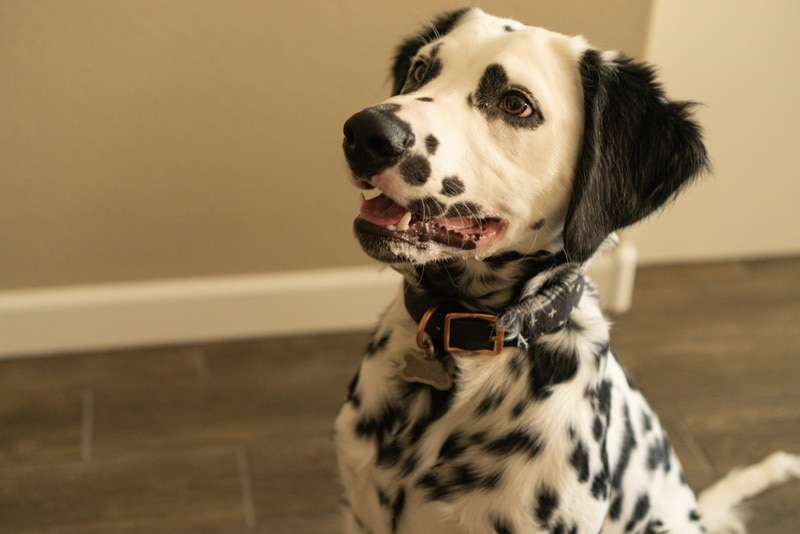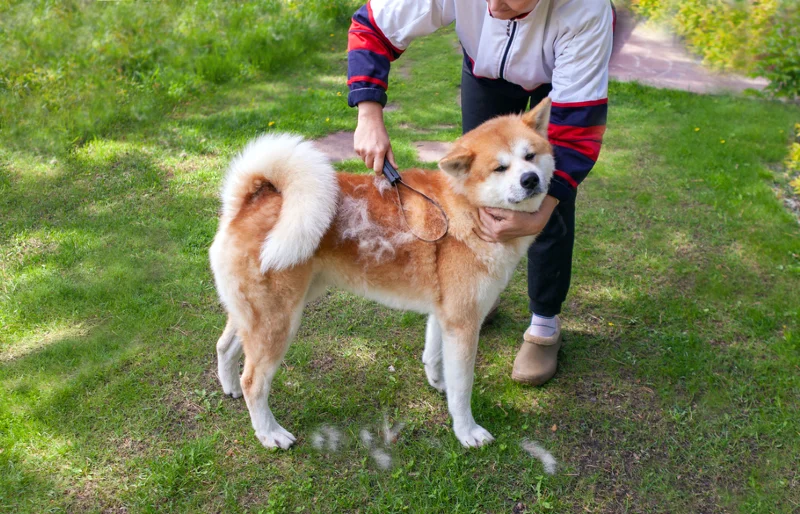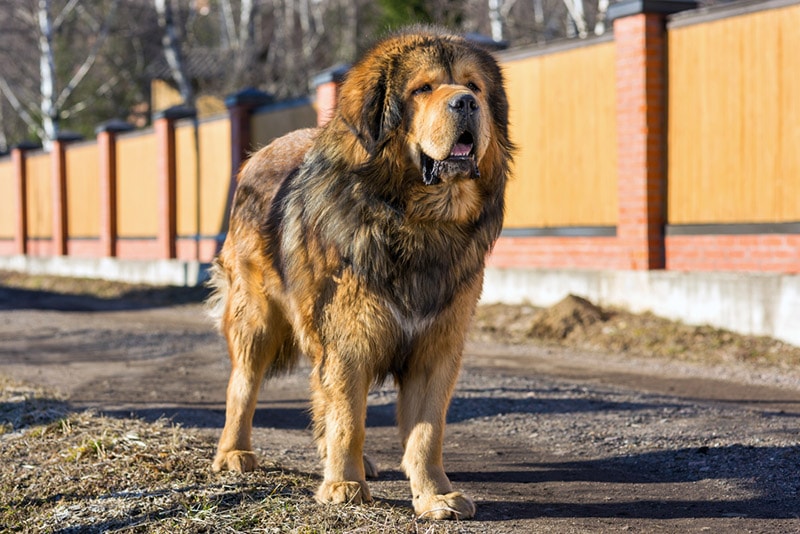Long-Haired Dalmatian: Pictures, Facts & History
Updated on

Click to Skip Ahead
Although nearly everyone has heard of Dalmatians, very few people have ever seen one. Why? Because few breeders are breeding this somewhat famous, eye-catching dog. However, while the Dalmatian is relatively rare, the long-haired Dalmatian is even rarer. How are long-haired Dalmatians different, and why do they have a relatively unique coat? To find out and learn much more about this graceful dog with its distinctive black spots and long hair, read on!
| Height: | 19 – 24 inches |
| Weight: | 45 – 70 pounds |
| Lifespan: | 11 – 13 years |
| Colors: | White and black, white and liver brown |
| Suitable for: | Young families, singles, and seniors looking for a loyal, calm, and affectionate dog |
| Temperament: | Intelligent, loyal, calm but energetic, playful, and sensitive |
Long-haired Dalmatians, genetically speaking, are nearly identical to traditional, short hair Dalmatians. The one difference, of course, is the long hair, which is caused by a recessive but naturally occurring gene dubbed the “LC gene” (for “long coat”). Luckily, this recessive gene is not known to cause any physical or cognitive differences or health issues. The biggest difference in caring for an LC Dalmatian is the need for extra brushing to keep their coat from getting matted and tangled. Like all Dalmatians, a long-haired Dalmatian must be well-socialized from puppyhood to ensure fewer issues with aggression towards strangers and other animals.
Long-Haired Dalmatian Breed Characteristics
The Earliest Records of Long-Haired Dalmatians in History
Amazingly, the history of the long-haired Dalmatian begins in Croatia in the 1300s in a region, not surprisingly, known as Dalmatia. Dalmatians were excellent hunting dogs but were also striking in their appearance and became well-known in Western Europe. Fascinatingly, besides hunting, Dalmatians were bred to be coach-guarding dogs for royal coaches and caravans, especially in ancient Rome. That’s why it’s often difficult to determine their true origin as Dalmatians. It’s also why, in England, Dalmatians were known as the English Coach Dog.
In the latter part of the 1800s, Dalmatians, including long-haired Dalmatians, started being exported to other parts of the world. That included the United States, where the breed quickly became popular.
How Long-Haired Dalmatians Gained Popularity
Dalmatians, and to a lesser extent long-haired Dalmatians, became famous in the United States fast once they arrived here, thanks to their lovely spots and luxurious coats. It was in 1956 that their popularity flew through the roof. That’s when English author Dodie Smith’s “The Hundred and One Dalmatians” was released, which was followed up 5 years later by the incredibly popular Disney movie of the same name.
Of course, the Dalmatians in the books and movies were the traditional short-haired type, and thus the short-haired type’s popularity took off. That’s why, today, long-haired or LC Dalmatians aren’t nearly as popular or well-known as their short-haired cousins. Because of their luxurious and genuinely gorgeous coats, many prefer the long-haired Dalmatian to the traditional, short-haired type.
Formal Recognition of Long-Haired Dalmatians
Because of the recessive gene that gives the long-haired Dalmatian its special coat, they have not been formally recognized by the American Kennel Club (AKC). Ironically, the LC Dalmatian is considered a purebred dog, but the recessive gene that gives them their luxurious coat disqualifies them from being recognized, at least for now.
There is good news on this front, however, as you can enter your long-haired Dalmatian in several AKC activities, including obedience drills, agility courses, and dock diving competitions, among several others. It’s hoped that, in the near future, the AKC will change its stance and allow LC Dals to join their cousins in the ranks of the formally recognized.
Top 7 Unique Facts About Long-Haired Dalmatians
1. Long-haired Dalmatians Have Been Around Just as Long as Their Traditional Cousins
Although not as popular, LC Dalmatians have been around since the beginning. The LC gene shows up in about 6% of all Dalmatian puppies, so about 6 out of 100 are born with long, luxurious hair. That’s been happening since they were first seen in the 1300s.
2. Dalmatians Take a Long Time to Mature
Unlike most breeds that mature between 1 and 2 years old, the Dalmatian, and the LC Dalmatian, don’t truly mature until they’re between 4 and 6 years old. For that reason, Dalmatians will demand more activity than most dogs in their first few years of life.
3. Dalmatians Were the Preferred Dogs of Ancient Roman rulers
Dalmatians traveled the ancient world at the side of many Roman rulers. They were bred to be coach dogs and guard coaches and their horses while the coaches were moving throughout Europe. The Romans ruled almost the entire civilized world at one point, and Dalmatians were seen everywhere they went.
4. Long and Short-Haired Dalmatians Shed Often
You should always keep a brush handy to ensure your Dalmatian looks good and their coat stays healthy and clean. If you don’t Bruch them often, most Dalmatians, especially the long-haired type, will be a mess in short order. For this reason, neither Dalmatian is a good choice for those with allergies.
5. Dalmatians Love to Swim
The typical Dalmatian, long or short-haired, loves the water and will gladly take a dip in a lake, pond, river, or ocean. Like most dogs, Dalmatians are good swimmers with innate swimming abilities.
6. Their Long Hair Makes Owning an LC Dalmatian Somewhat Easier
With short-haired Dalmatians, the hair is stiff and clings to everything, especially upholstery and clothing. Long-haired Dalmatians have softer, silkier hair that doesn’t stick to everything like glue and is thus easier to clean up.
7. The Brindle Dalmatian Is the Rarest Color
It’s extremely rare to find a brindle Dalmatian with a sable or dawn base coat. The same goes for so-called “trindle” Dalmatians, with brindle showing in their tri-colored spots. Unfortunately, none of these colors is accepted by the AKC.
Do Long-Haired Dalmatians Make Good Pets?
Dalmatians generally are affectionate, calm, loyal dogs when socialized well. Yes, they have a reputation for being a bit aggressive, but any dog raised poorly can misbehave. When raised by a caring owner and family, the average LC Dalmatian will be a wonderful pet, loving companion, and good watchdog.
Long-haired Dalmatians need a lot of activity and exercise to stay healthy and happy. About 2 hours a day is recommended and should be kept up until your Dalmatian is well into middle age as they mature more slowly than most breeds. Also, daily brushing is critical when you’re the parent of a long-haired Dalmatian, as they shed a lot, and their hair can become matted and tangled quite quickly.
Lastly, long-haired Dalmatians make good dogs for apartments because they don’t bark excessively, with the caveat that they need to be outside and running around every day. If you can do that, they will be content in a smaller space and won’t drive your neighbors crazy by barking.
Final Thoughts
Besides the obvious difference in their hair, the long-haired Dalmatian is no different from its shorthaired cousin. It is, however, coveted for this difference by some dog fanciers as their long hair is striking and gorgeous. They might not have had a starring Disney role, but for some, the LC Dalmatian is the more beautiful choice.
If you’ve been a fan of this attractive dog and want one with long hair, do your due diligence in finding a reputable, compassionate breeder that breeds with great care. That way, health issues will be fewer, and you and your pup will have many long, happy, and healthy years together.
Featured Image Credit: SCEDIT, Shutterstock













